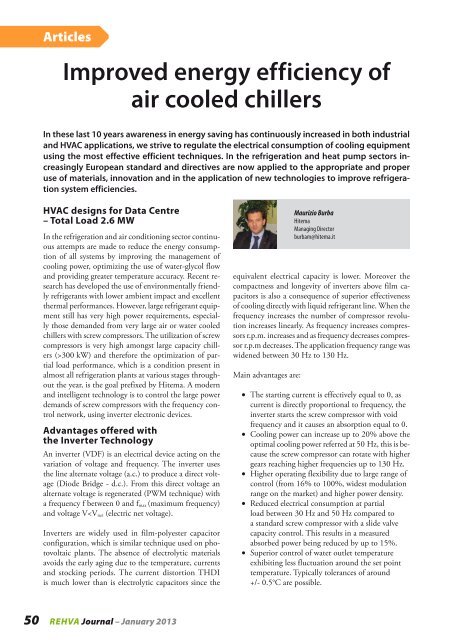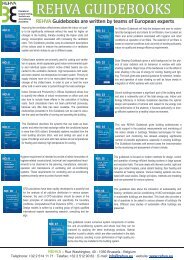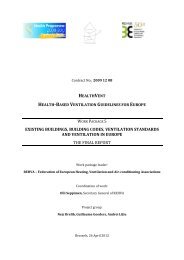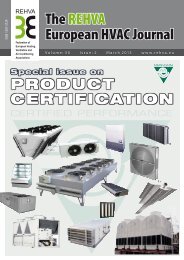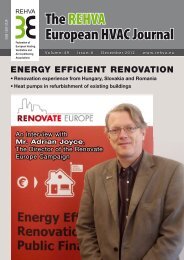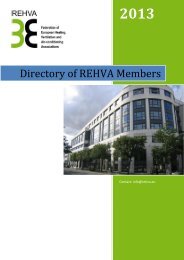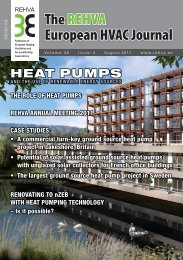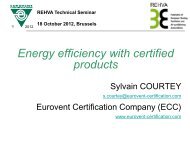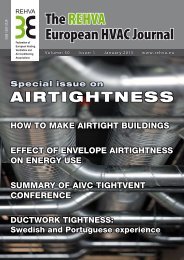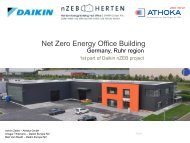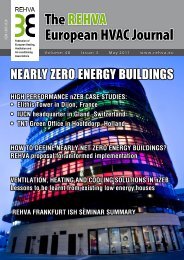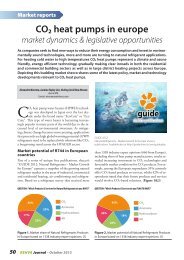Improved energy efficiency of air cooled chillers (PDF 387 kB) - rehva
Improved energy efficiency of air cooled chillers (PDF 387 kB) - rehva
Improved energy efficiency of air cooled chillers (PDF 387 kB) - rehva
Create successful ePaper yourself
Turn your PDF publications into a flip-book with our unique Google optimized e-Paper software.
Articles<br />
<strong>Improved</strong> <strong>energy</strong> <strong>efficiency</strong> <strong>of</strong><br />
<strong>air</strong> <strong>cooled</strong> <strong>chillers</strong><br />
In these last 10 years awareness in <strong>energy</strong> saving has continuously increased in both industrial<br />
and HVAC applications, we strive to regulate the electrical consumption <strong>of</strong> cooling equipment<br />
using the most effective efficient techniques. In the refrigeration and heat pump sectors increasingly<br />
European standard and directives are now applied to the appropriate and proper<br />
use <strong>of</strong> materials, innovation and in the application <strong>of</strong> new technologies to improve refrigeration<br />
system efficiencies.<br />
HVAC designs for Data Centre<br />
– Total Load 2.6 MW<br />
In the refrigeration and <strong>air</strong> conditioning sector continuous<br />
attempts are made to reduce the <strong>energy</strong> consumption<br />
<strong>of</strong> all systems by improving the management <strong>of</strong><br />
cooling power, optimizing the use <strong>of</strong> water-glycol flow<br />
and providing greater temperature accuracy. Recent research<br />
has developed the use <strong>of</strong> environmentally friendly<br />
refrigerants with lower ambient impact and excellent<br />
thermal performances. However, large refrigerant equipment<br />
still has very high power requirements, especially<br />
those demanded from very large <strong>air</strong> or water <strong>cooled</strong><br />
<strong>chillers</strong> with screw compressors. The utilization <strong>of</strong> screw<br />
compressors is very high amongst large capacity <strong>chillers</strong><br />
(>300 kW) and therefore the optimization <strong>of</strong> partial<br />
load performance, which is a condition present in<br />
almost all refrigeration plants at various stages throughout<br />
the year, is the goal prefixed by Hitema. A modern<br />
and intelligent technology is to control the large power<br />
demands <strong>of</strong> screw compressors with the frequency control<br />
network, using inverter electronic devices.<br />
Advantages <strong>of</strong>fered with<br />
the Inverter Technology<br />
An inverter (VDF) is an electrical device acting on the<br />
variation <strong>of</strong> voltage and frequency. The inverter uses<br />
the line alternate voltage (a.c.) to produce a direct voltage<br />
(Diode Bridge - d.c.). From this direct voltage an<br />
alternate voltage is regenerated (PWM technique) with<br />
a frequency f between 0 and f max (maximum frequency)<br />
and voltage V
Articles<br />
COP - EER<br />
Power [kW]<br />
65<br />
55<br />
45<br />
• Reduced mechanical<br />
Compressor<br />
compressors<br />
absorbed<br />
wear,<br />
power<br />
as the<br />
screw will rotate for most <strong>of</strong> year with reduced<br />
r.p.m. (higher MTBF).<br />
• Inverter technology with screw compressor<br />
variable Vi, using automatic control <strong>of</strong> Vi the<br />
performances <strong>of</strong> chiller increase.<br />
Performance <strong>of</strong> a Hitema chiller with<br />
compressors driven by inverter<br />
35<br />
Power [kW]<br />
Figure 1. Comparison with <strong>of</strong> slide performance valve with inverter <strong>of</strong> <strong>chillers</strong>.<br />
Figure 1 illustrates the first important point showing<br />
lower absorbed power <strong>of</strong> the screw compressor when<br />
installed with an inverter, compared against a standard<br />
screw compressor with a slide valve. Chiller with inverter<br />
screw compressors are more versatile and highly<br />
efficient specialists used in <strong>chillers</strong> for <strong>air</strong> conditioning<br />
systems and industrial process cooling.<br />
chiller and the total power consumption <strong>of</strong> the refrigeration<br />
unit (compressors + fans). If the cooling load decreases<br />
whilst the ambient temperature decreases, then<br />
the absorbed power <strong>of</strong> chiller decreases much more rapidly<br />
than the reduction in cooling capacity in a non-linear<br />
relationship.<br />
These COP and EER values are very competitive with<br />
other available technologies (eg, centrifugal compressors)<br />
and COP values with inverter screw compressors<br />
can attain >8 and EER >7. This chart above refers to an<br />
<strong>air</strong> <strong>cooled</strong> chiller with R-134A refrigerant, with inlet water<br />
temperature <strong>of</strong> 12°C and outlet water temperature<br />
<strong>of</strong> 7°C. The graph illustrates the massively beneficial effect<br />
on the <strong>efficiency</strong> <strong>of</strong> the chiller unit as the ambient<br />
<strong>air</strong> temperature and the load on the chiller reduce from<br />
100% load in a 35°C ambient (worse case), to a situation<br />
whereby the load on the chiller is 50% and the ambient<br />
temperature is 15°C. As can be clearly observed,<br />
the EER for the unit at 50% load in a 15°C ambient is<br />
over double (~7) the value compared to when at 100%<br />
load in a 35°C ambient temperature (~3). The thermal<br />
performances indicated demonstrate that this unit easily<br />
qualifies for Class A <strong>efficiency</strong> categorisation.<br />
It is clearly important to know the ambient temperature,<br />
the water temperature and the maximum load during<br />
the year (month by month) in order to assess the real<br />
operating <strong>efficiency</strong> <strong>of</strong> chiller unit.<br />
With a slide valve the gas flow control is less accurate<br />
than the inverter controlled counterpart. With a standard<br />
compressor the capacity steps are 7 static and prefixed 7<br />
December<br />
(eg, 100%, 75%, 50% and 25%). With the inverter solution,<br />
the screw revolution decreases 6.5<br />
6.5<br />
December<br />
9<br />
January<br />
proportionally<br />
January 6<br />
November<br />
8 and the gas flow is modulated linearly. 6<br />
5.5<br />
March November<br />
7<br />
9<br />
5.5<br />
5<br />
March<br />
6<br />
8<br />
COP<br />
4.5<br />
October<br />
5<br />
EER<br />
5<br />
EER<br />
4<br />
July<br />
7<br />
3.5 October<br />
4<br />
4.5<br />
6<br />
COP<br />
3<br />
3<br />
4<br />
July<br />
5<br />
EER<br />
0 2 4 6 8<br />
2<br />
4<br />
3.5<br />
Month<br />
40 60 80 100<br />
3<br />
3<br />
Load [%]<br />
Figure 3. EER value <strong>of</strong> a chiller without free cooling.<br />
2<br />
0<br />
<br />
2 4 6 8<br />
40 60 80 100<br />
Figure Month 3 shows the EER value trend <strong>of</strong> a chiller without<br />
Load [%]<br />
free cooling when operating with a water outlet temperature<br />
<strong>of</strong> <br />
<br />
Figure 2. Performance for <strong>air</strong> <strong>cooled</strong> chiller.<br />
5°C.<br />
COP - EER<br />
65<br />
Compressor absorbed power<br />
25<br />
Compressor absorbed power<br />
55<br />
40 50 60 70 80 90 100 110<br />
45<br />
Load [%]<br />
35<br />
with slide valve with inverter<br />
25<br />
40 50 60 70 80 90 100 110<br />
Load [%]<br />
EER<br />
<br />
EER<br />
EER<br />
<br />
Figure 2 illustrates the real data performance for <strong>air</strong><br />
<strong>cooled</strong> chiller. The COP is the ratio between cooling<br />
capacity and the compressor absorbed power input. The<br />
EER is the relationship between the cooling capacity <strong>of</strong><br />
This chiller is designed for 680 kW at full load. During<br />
the warmer months <strong>of</strong> the season (June-August) the required<br />
load is 100%, whilst during the colder period<br />
(November-March), when ambient temperature is much<br />
REHVA Journal – January 2013 51
Articles<br />
Hitema also <strong>of</strong>fer the use <strong>of</strong> inverters applicable to the<br />
standard axial fans. To control the volume <strong>of</strong> <strong>air</strong> circulated<br />
through the condenser in the <strong>air</strong> <strong>cooled</strong> <strong>chillers</strong> sim-<br />
lower, the chiller load is estimated between 50% and Table 1. Weighting factors <strong>of</strong> part load efficiencies for<br />
60%. It is interesting to observe that the EER in the hotter<br />
months, during the worst demanding ambient condi-<br />
calculating European Seasonal Energy Efficiency Ratio.<br />
8<br />
7.5<br />
Water leaving temperature (°C)<br />
7 (constant)<br />
tions, has a minimum value <strong>of</strong> 4, whilst when the chiller Delta T full load (°C) 5<br />
7<br />
load is around 60%, the EER values are typically between Load (%)<br />
100 75 50 25<br />
6.5<br />
Water Cooled Chiller<br />
6 and 7, much higher than a standard chiller. All these values<br />
refer to the maximum ambient temperature for each<br />
6<br />
Condenser water temperature (°C) 30 26 22 18<br />
5.5<br />
Air Cooled Chiller<br />
month, 8 so these EER are considered as a minimum.<br />
Condenser <strong>air</strong> temperature (°C) 35 30 25 20<br />
5<br />
Weight in ESEER (%)<br />
3 33 41 23<br />
7.58<br />
4.5<br />
7.5 7<br />
4<br />
6.57<br />
ple fan speed regulators to cut the phase applied to the<br />
0 5 10 15 20<br />
fan<br />
25<br />
motor<br />
30<br />
6.5 6<br />
are currently widely used. With this method,<br />
Time<br />
5.56<br />
it is possible to decrease the rotation <strong>of</strong> the motor intervening<br />
directly on the supply voltage. However, with the<br />
5.5 5<br />
Outlet temperature use <strong>of</strong> inverters, which modulate the frequency from 20<br />
4.55<br />
to 50 Hz it is possible to reduce steadily the <strong>air</strong> flow and<br />
4.5 4<br />
achieve improved condensing control.<br />
4 0 5 10 15 20 25 30<br />
0 5 10 15 Time 20 25 30<br />
Benefits obtained by the use <strong>of</strong> frequency variation with<br />
Figure 4. Outlet water temperature. Time<br />
respect to voltage variation are the following:<br />
Outlet temperature<br />
Figure 4 shows the outlet<br />
Outlet<br />
water<br />
temperature<br />
<br />
temperature trend. • Reduced noise levels<br />
<br />
Inverter control achieves much greater water temperature<br />
control than is possible with a standard screw comeration<br />
in the <strong>air</strong> conditioning sector, as <strong>air</strong> <strong>cooled</strong><br />
This is a key point when using axial fans for refrigpressor.<br />
It is evident that the water temperature fluctuation<br />
is only +/- 0.5°C deviation from the set point. plications; when installed with fans operating from<br />
<strong>chillers</strong> are widely used in residential, external ap-<br />
Furthermore the set point value is established more rapidly<br />
than on standard a chiller.<br />
tions up to 6 dBA for the same chiller unit are pos-<br />
a variable frequency drive, significant noise reducsible<br />
(ISO3744).<br />
Temperature [°C]<br />
Temperature [°C]<br />
Temperature [°C]<br />
In the European market the adopted index to classify<br />
chiller performance is E.S.E.E.R. (European Seasonal<br />
Energy Efficiency Ratio) and this is in accordance<br />
with E.E.C.C.A.C. proposal (Energy Efficiency and<br />
Certification <strong>of</strong> Central Air Conditioner). HITEMA<br />
inverter driven screw <strong>chillers</strong> has E.S.E.E.R. <strong>of</strong> over 5.<br />
The formula used to calculated this is:<br />
ESSER=<br />
0.03 x EER(100%) + 0.33 x EER(75%) + 0.41 x EER(50%) + 0.23 x EER(25%)<br />
The EER value (%) is the <strong>efficiency</strong> <strong>of</strong> chiller at 100%,<br />
75%, 50%, 25% <strong>of</strong> load under various conditions in accordance<br />
with Table1.<br />
For <strong>chillers</strong> with screw compressor installed with inverter<br />
control and variable Vi compressor, the increase<br />
achieved in the E.S.E.E.R. is around 15%.<br />
Axial Fans for Condenser with inverter<br />
• Lower <strong>energy</strong> consumption<br />
For low-medium speed (rpm) the frequency variation<br />
allows reduced power consumption. However<br />
the motor <strong>efficiency</strong> is completely utilized with all<br />
cooling load. A cut phase adjustable fan-motor has<br />
an <strong>efficiency</strong> ratio between 72−74% whereas the<br />
same motor with frequency driver has a performance<br />
ratio <strong>of</strong> 80%.<br />
HITEMA uses another innovative application around<br />
the <strong>air</strong> fans, that it consists in the use <strong>of</strong> a special diffuser<br />
on top <strong>of</strong> the fans (Figure 5), that allows:<br />
• Noise reduction <strong>of</strong> 6 dBA.<br />
• Energy Saving <strong>of</strong> 22%.<br />
Centrifugal process pump (2-4 poles)<br />
with Inverter<br />
Hitema proposes the application <strong>of</strong> the inverter control<br />
on one or more centrifugal pumps, in order to obtain<br />
a non-dissipative regulation <strong>of</strong> power with the pump<br />
speed variation, depending on the heat load required.<br />
(Figure 6 and Figure 7)<br />
52<br />
REHVA Journal – January 2013
Articles<br />
Figure 5. Special diffuser<br />
for <strong>air</strong> fans.<br />
Hence we obtain significant results in <strong>energy</strong> saving<br />
as you trace the real load <strong>energy</strong> requirements without<br />
any additional loss or consumption being incurred by<br />
the process.<br />
To understand how the non-dissipative adjustment is<br />
able to act in this method, we can consider the operating<br />
curve <strong>of</strong> a centrifugal pump. (Figure 8)<br />
The intersection <strong>of</strong> the characteristic operating range for<br />
centrifugal pump with the typical flow-pressure curve<br />
can be used to identify the point <strong>of</strong> working regime<br />
(point A for 100% <strong>of</strong> load). If the load in the system requires<br />
a flow <strong>of</strong> 75% <strong>of</strong> the maximum by the regulation<br />
by the classic choke valve installed after the pump then<br />
an additional pressure drop is artificially introduces and<br />
the system must overcame a higher pressure drop (kPa<br />
or m.w.c.) than is actually required by load (point B).<br />
Furthermore by moving the operating flow point, the<br />
pump <strong>efficiency</strong> is also changed, which then introduces<br />
a further <strong>efficiency</strong> loss.<br />
By adjusting inverter frequency instead, it follows the<br />
real load demand by altering the pump curve. (Figure 9).<br />
Varying the speed <strong>of</strong> the pump changes its actual operating<br />
curve, which will move vertically downwards and<br />
thus we reach into the new operating point (point C)<br />
without any adjustment valve introduction. This results<br />
in a real <strong>energy</strong> saving <strong>of</strong> 30%.<br />
The process pumps when installed with an inverter can<br />
effectively have zero starting current if the water flow<br />
can be gradually increased up to the maximum flow,<br />
which again avoids potentially water hammer. The correct<br />
management <strong>of</strong> the inverter location completes the<br />
full system optimization.<br />
Conclusion<br />
Figure 6. Inverter driven<br />
Figure 7. Electrical board<br />
double pump.<br />
140<br />
with inverters for pumps.<br />
120<br />
B<br />
140<br />
140 140<br />
A<br />
120 100<br />
120<br />
B<br />
120<br />
B<br />
B<br />
A<br />
A<br />
A<br />
100 80<br />
100 100<br />
80 60<br />
80 80<br />
60 40<br />
60 60<br />
2040<br />
40<br />
200<br />
20 20<br />
0<br />
000<br />
20 40 60 80 100 120 140<br />
0<br />
0 0 20<br />
20<br />
40 20 40<br />
60<br />
60 Flow 40 rate<br />
80<br />
80 [%]<br />
100<br />
100 60 120<br />
120 80 140<br />
140 100<br />
Flow rate [%]<br />
Flow rate [%] Flow rate [%]<br />
Resistance curve at 100% Resistance curve at partial load Pump curve<br />
Resistance<br />
Resistance Resistance curve at 100%<br />
curve 100% curve Resistance at Resistance 100% curve at partial<br />
curve at partial Resistance load Pump<br />
load Pump curve<br />
curve at partial load<br />
Figure 8. Operating curve <strong>of</strong> a centrifugal pump. <br />
<br />
140<br />
Head Head pressure pressure [%] [%]<br />
Head pressure [%]<br />
Head pressure [%]<br />
140 140 140 120<br />
120 120 120 100<br />
B<br />
A<br />
B<br />
A<br />
100 100 100 80<br />
C<br />
80 8060<br />
80<br />
C<br />
60 6040<br />
60<br />
40 4020<br />
40<br />
20 20 20 0<br />
0 0<br />
0 20 40 60 80 100 120 140<br />
0<br />
0 0 20<br />
20<br />
40 20 40<br />
60<br />
60 4080 Flow rate 80[%]<br />
100<br />
100 60 120<br />
120 80 140<br />
140 100<br />
Flow rate [%]<br />
Flow rate [%] Flow rate [%]<br />
Resistance curve at 100% Pump curve at 100% Pump curve at reduced speed<br />
Resistance Resistance curve at 100% curve Resistance at 100% curve at partial Resistance load Pump curve at partial load<br />
Figure Resistance 9. curve Operating 100% curve Pump curve with at 100% speed Pump pump curve variation.<br />
at reduced speed <br />
<br />
<br />
Head pressure [%]<br />
Head pressure [%]<br />
Head pressure [%]<br />
Today there are many applications that require effective<br />
and innovative solutions to reduce the absorbed<br />
powers requirements <strong>of</strong> refrigeration hardware in process<br />
cooling industries, commercial <strong>air</strong> conditioning and<br />
data centres facilities. The optimum operation <strong>of</strong> refrigeration<br />
equipment at partial loads is especially significant<br />
in condition where the medium annual ambient<br />
<strong>air</strong> temperatures are between +5°C and +20°C, typical<br />
for the vast majority <strong>of</strong> European conditions. For<br />
even lower ambient temperatures the combination <strong>of</strong><br />
inverter technology coupled with that <strong>of</strong> free-cooling,<br />
whereby chilled water can be produce using only fans<br />
<strong>energy</strong>, can be effectively used to produce chiller units<br />
with even greater efficiencies than previously considered<br />
possible.<br />
REHVA Journal – January 2013 53


